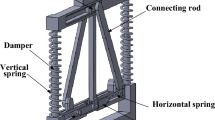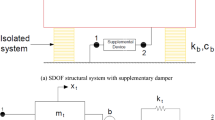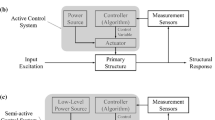Abstract
Background
In the existing studies, the hysteretic model of tensioner is applied in analysis of a belt drive system which can improve the computational accuracy. But the computational efficiency is low and not suitable for system optimization.
Purpose
In this paper, an approach is presented to simplify the tensioner’s hysteretic model into an equivalent stiffness and damping which is used for improving the computational efficiency of vibration responses of the belt drive system.
Method
A simplified model and computation method of a belt drive system is established. The hysteretic model of a belt tensioner consists of a linear stiffness and viscous damping based on the averaging energy method to simplify the hysteretic parameters and improve the computational efficiency. The equivalent linear stiffness and damping of the tensioner are estimated using an iterative technique. A timing belt drive system is considered as a case study. The belt system's vibration responses are obtained and compared with the measured results to evaluate the performance of the presented approach.
Results and conclusion
The computational results are compared with a previously published method, and the difference between the proposed method (Method I) and the previously published method (Method II) is discussed. The presented method has the following merits: (1) The linearization of tensioner’s hysteretic model can improve the computational efficiency greatly with an acceptable computational accuracy. (2) The semi-analytic method which is used to derive the system equations can further reduce the amount of computation. It is suitable for parameter optimization of system.





















Similar content being viewed by others
References
Chiariotti P, Martarelli M, Castellini P (2017) Exploiting continuous scanning laser doppler vibrometry in timing belt dynamic characterization. Mech Syst Signal Process 86(pt B):66–81
Zhu H, Zhu W, Fan W (2020) Dynamics modeling, simulation and experiment of power transmission belt drives: a systematic review. J Sound Vib 491:1–41
Wang X, Zhu W (2016) Dynamic analysis of an automotive belt-drive system with a noncircular sprocket by a modified incremental harmonic balance method. ASME J Vib Acoust 139(1):011009(1–13)
Zhu H, Hu Y, Pi Y (2014) Transverse hysteretic damping characteristics of a serpentine belt: modeling and experimental investigation. J Sound Vib 333(25):7019–7035
Shangguan WB, Zeng X (2013) Modeling and validation of rotational vibration responses for accessory drive system-part II: simulations and analyses. ASME J Vib Acoust 135(3):031003(1–13)
Zhu H, Hu Y, Pi Y, Zhu W (2019) Hysteretic damping characteristics of a mechanical tensioner: modeling and experimental investigation. Proc Inst Mech Eng Part D J Automob Eng 233(7):1890–1902
Long S, Zhao X, Shangguan WB (2020) Method for estimating vibration responses of belt drive systems with a nonlinear tensioner. Nonlinear Dyn 100(3):2315–2335
Zhao J, Barker C, Oliver L (1998) Experimental testing and modeling of automotive automatic belt tensioners. SAE Tech Pap 980839:1–13
Bastien J, Michon G, Manin L, Dufour R (2007) An analysis of the modified Dahl and Masing models: application to a belt tensioner. J Sound Vib 302(4):841–864
Michon G, Manin L, Dufour R (2005) Hysteretic behavior of a belt tensioner: modeling and experimental investigation. J Vib Control 11(9):1147–1158
Hwang SJ, Perkins NC, Ulsoy AG, Mechkstroth RJ (1994) Rotational response and slip prediction of serpentine belt drives systems. ASME J Vib Acoust 116(1):71–78
Ding H, Li D (2014) Static and dynamic behaviors of belt-drive dynamic systems with a one-way clutch. Nonlinear Dyn 78(2):1553–1575
Ding H, Lim CW, Chen LQ (2018) Nonlinear vibration of a traveling belt with non-homogeneous boundaries. J Sound Vib 424(23):78–93
Kraver TC, Fan GW, Shah JJ (1996) Complex modal analysis of a flat belt pulley system with belt damping and coulomb-damped tensioner. ASME J Mech Des 118:306–311
Farong Z, Parker RG (2005) Non-linear dynamics of a one-way clutch in belt–pulley systems. J Sound Vib 279(1–2):285–308
Farong Z, Parker RG (2008) Influence of tensioner dry friction on the vibration of belt drives with belt bending stiffness. ASME J Vib Acoust 130(1):1161–1171
Cheng G, Zu JW (2003) Nonstick and stick-slip motion of a coulomb-damped belt drive system subjected to multifrequency excitations. ASME J Appl Mech 70(6):871–884
Zhu H, Hu Y, Zhu W, Pi Y (2017) Optimal design of an auto-tensioner in an automotive belt drive system via a dynamic adaptive PSO-GA. ASME J Mech Des 139(9):093302(1–12)
Long S, Zhao X, Shangguan WB, Zhu W (2020) Modeling and validation of dynamic performances of timing belt driving systems. Mech Syst Signal Process 144(1):1–24
Wang X, Zhu WD (2017) Dynamic analysis of an automotive belt-drive system with a noncircular sprocket by a modified incremental harmonic balance method. ASME J Vib Acoust 139(1):011009(1–13)
Zhu H, Zhu W, Hu Y (2018) Periodic response of a timing belt drive system with an oval cogged pulley and optimal design of the pitch profile for vibration reduction. ASME J Comput Nonlinear Dyn 13(1):011014(1–13)
Acknowledgements
The paper is supported by the National Natural Science Foundation of China (No. 51775122).
Author information
Authors and Affiliations
Corresponding author
Ethics declarations
Conflict of interest
The authors declare that they have no conflict of interest.
Additional information
Publisher's Note
Springer Nature remains neutral with regard to jurisdictional claims in published maps and institutional affiliations.
Rights and permissions
About this article
Cite this article
Long, S., Wang, W., Yue, X. et al. Dynamic Modeling of the Belt Drive System with an Equivalent Tensioner Model. J. Vib. Eng. Technol. 10, 511–525 (2022). https://doi.org/10.1007/s42417-021-00389-5
Received:
Revised:
Accepted:
Published:
Issue Date:
DOI: https://doi.org/10.1007/s42417-021-00389-5






